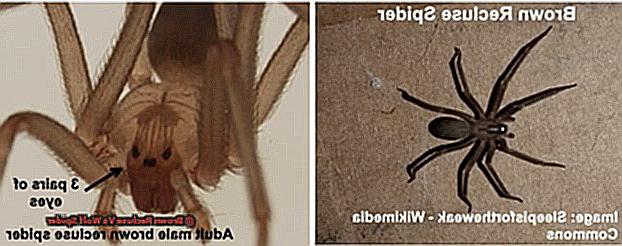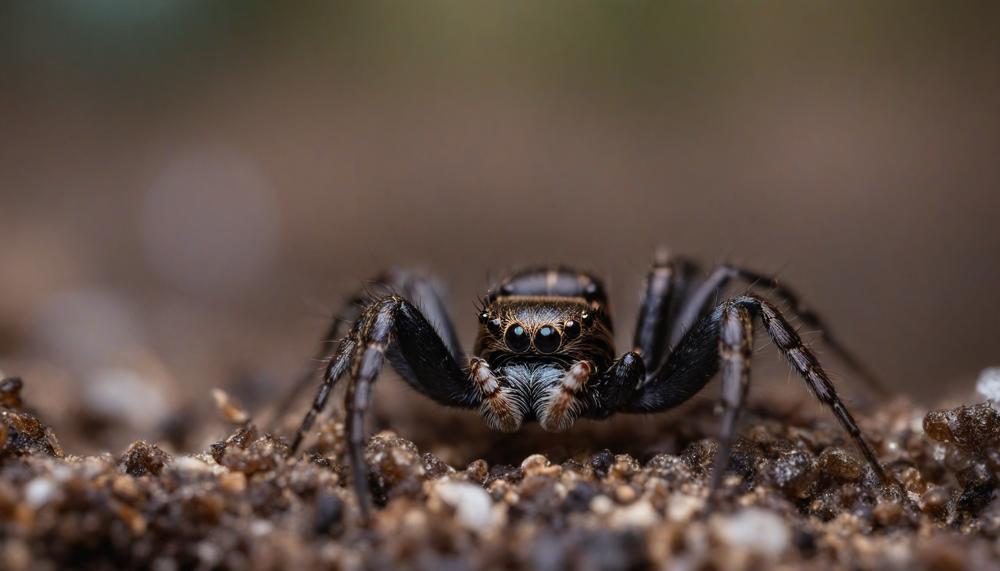The world of spiders is a mysterious and often misunderstood one.
With their eight legs and multiple eyes, they can appear both fascinating and fearsome at the same time. But not all spiders are created equal.
In fact, two commonly mistaken species are the brown recluse and wolf spider. While both may have a reputation for being venomous and dangerous, they each have distinct qualities that set them apart from one another.
So grab your magnifying glass and join us as we unravel the truth about brown recluses and wolf spiders – two creatures that may seem similar but couldn’t be more different.
Table of Contents
Appearance and Identification
For many, spiders are a source of fear and discomfort, especially when they are venomous. Among the most commonly mistaken spiders are the brown recluse and the wolf spider. Despite their initial resemblance, these two arachnids possess unique traits and behaviors that set them apart. In this article, we will delve into the perplexing world of these spiders and uncover the key elements to accurately identify them.
Appearance:
The primary way to distinguish between a brown recluse and a wolf spider is through their appearance. Brown recluses are slender and have a much darker color compared to the stockier wolf spiders. Their bodies are light brown or tan with a distinctive violin-shaped marking on their head. On the contrary, wolf spiders have more intricate patterns on their backs, with stripes or spots in varying shades of gray, brown, or black.
Size:
Another striking difference between these two spiders is their size. Wolf spiders can grow up to 2 inches in length, while brown recluses are significantly smaller, measuring around ¼ inch. Therefore, encountering a large spider most likely indicates a wolf spider rather than a brown recluse.
Number of Eyes:
Perhaps one of the most intriguing distinctions between these two spiders is their number of eyes. Wolf spiders have eight eyes arranged in three rows, while brown recluses only have six eyes arranged in pairs. This unique eye structure can aid in correctly identifying the spider species.
Behavior:
The behavior of these two spiders can also provide valuable hints in distinguishing between them. Wolf spiders are known to be more aggressive and will not hesitate to attack when threatened. They can often be found wandering in open areas and may even enter houses. On the other hand, brown recluses are more timid and will only bite if provoked. They tend to inhabit dark, undisturbed places like closets or basements.
Venom:
Although both brown recluses and wolf spiders are venomous, their bites have vastly different effects. Brown recluse venom is necrotic, causing tissue damage and ulcers. In contrast, wolf spider venom is relatively mild, resulting in only minor pain and irritation.
Distribution and Range

Let us delve into this perplexing query and unveil the truth behind these commonly confused arachnid species.
Habitat:
Wolf spiders are adaptable creatures, flourishing in a variety of surroundings, including forests, grasslands, wetlands, and even human dwellings. They prefer dim, damp areas with an abundance of hiding spots to pursue their prey. On the contrary, brown recluse spiders are more solitary and gravitate towards secluded places like woodpiles, unused garments, and storage crates. They tend to shun human contact and can be discovered lurking in the shadows of homes.
Hunting Behavior:
Wolf spiders are active predators, utilizing their exceptional vision to track and capture their prey under the cover of darkness. Their distinct eye arrangement enables them to have a 360-degree view, making them proficient hunters. In contrast, brown recluse spiders ensnare their victims with webs by taking them by surprise. They rarely abandon their webs and rely on their prey to become ensnared in their sticky traps.
Venom Effects:
While both species possess venom, there is a significant difference in its effects on humans. Wolf spider bites may cause mild symptoms such as swelling and itching but are generally not deemed medically significant. However, brown recluse bites can result in severe complications due to the necrotic nature of their venom. If bitten by a brown recluse spider, it is crucial to seek immediate medical attention.
Prevention and Control:
To prevent spider infestations in your abode, it is imperative to maintain cleanliness and declutter your surroundings. Seal any crevices or entry points in your home to prevent spiders from entering. Moreover, remove any vegetation near the exterior of your house as it can serve as a refuge for spiders.
In case of an infestation, it is wise to vacuum or sweep up visible spiders and use glue traps or insecticides if necessary. However, in the event of a severe brown recluse spider infestation, it is best to seek professional pest control services.
In conclusion, comprehending the main disparities between wolf spiders and brown recluse spiders is vital for accurate identification and understanding their roles in preserving ecological balance. By being aware of their habitat, hunting behavior, and potential hazards, we can coexist with these creatures harmoniously.
Behavior and Hunting Style
Spiders, those eight-legged creatures that often send shivers down our spines, can be found in various shapes, sizes, and colors. With over 40,000 species worldwide, it can be challenging to distinguish between them. Today, we will delve into the world of two commonly confused spiders – the Brown Recluse and Wolf spiders. While they may share some similarities, their behavior and hunting style are what sets them apart.
Appearance and Habitat
One of the most striking differences between these two spiders is their appearance. The Brown Recluse spider, about the size of a quarter, has a distinct violin-shaped pattern on its cephalothorax. Unlike most spiders with eight eyes, this species has six eyes arranged in pairs. On the other hand, Wolf spiders boast eight legs and three rows of eight eyes. They come in various sizes and colors, but they tend to be larger than Brown Recluses.
When it comes to habitat, these two species also differ greatly. Brown Recluse spiders prefer dark and solitary places like closets, basements, and attics. You are most likely to find them in the southern and central United States. In contrast, Wolf spiders can be found in a wide range of environments such as fields, wooded regions, and grasslands. These solitary creatures do not spin webs but rely on their sharp vision for hunting.
Behavior and Hunting Style
The behavior of these two spiders is as diverse as their appearance and habitat. Brown Recluse spiders are not aggressive and resort to biting only when threatened. As nocturnal hunters, they prefer to stay hidden during the day and use their webs to ensnare prey before attacking.
In comparison, Wolf spiders are fierce predators with exceptional eyesight. They hunt alone and do not rely on webs for catching prey. Instead, they actively pursue their victims using their agility and speed. With their keen vision, they can spot their prey from a distance and pounce on them within seconds.
Venom and Potential Harm to Humans
While both of these spiders are venomous, the effects of their venom on humans differ significantly. The bite of a Brown Recluse spider can cause severe tissue damage due to its potent toxin and, in rare cases, even lead to systemic symptoms. On the other hand, a Wolf spider’s bite is usually harmless to humans. However, it is always best to seek medical attention for any spider bite to avoid potential complications.
Venom and Bites
Are you tired of dealing with pesky spiders invading your home? Do you fear their venomous bites and the potential harm they can cause? If so, you’re not alone. Many people share this sentiment, but before you go swinging your shoe at every eight-legged creature you see, it’s important to know the key differences between two commonly confused spiders – the Brown Recluse and Wolf spider.
Perplexed by the Potency:
One of the most perplexing differences between these two spiders is the potency of their venom. While both are venomous, the Brown Recluse has a more potent venom that can be fatal to humans. This fact alone can leave many scratching their heads, wondering why such a small creature could possess such deadly power.
A Burst of Symptoms:
Both spider bites can cause pain and swelling, but the symptoms differ greatly. A Brown Recluse bite can cause necrotic skin lesions and serious reactions, especially in children, requiring immediate medical attention. This burst of symptoms can quickly turn a seemingly harmless spider into a dangerous threat. On the other hand, a Wolf spider’s bite may cause pain and swelling, but it is considered mild and rarely causes severe reactions in humans. This difference in symptoms adds to the perplexity of these two spiders.
Preventing Unwanted Guests:
The best way to deal with spiders is to prevent them from entering your home in the first place. For both types of spiders, sealing cracks and holes, using scented oils or vinegar as deterrents, regular cleaning, and being mindful of fruit bowls can help keep them away. This proactive approach may seem simple, but it can save you from a burst of panic when encountering these creatures.
Appearance and Behavior:
While both spiders have similar body shapes and colors, there are distinct differences in their appearance and behavior. Wolf spiders have 8 eyes arranged in a line on their heads, giving them a burst of vision compared to the Brown Recluse’s 6 clustered eyes. Additionally, Wolf spiders are larger and more aggressive than brown recluses, with some species even having elaborate courtship rituals. These unique behaviors add to the burstiness of these creatures.
Habitat Havoc:
Brown recluses prefer dark and quiet places to hunt, such as attics, basements, and closets. This preference for hidden habitats adds to their perplexity, making them harder to spot and avoid.
Pest Control and Management
While most spiders are harmless, two species – the Brown Recluse and Wolf spider – are commonly mistaken for each other due to their similar appearance. However, there are key differences between these spiders that homeowners should be aware of to effectively control them.
Size and Appearance:
The first difference between these spiders is their size. Brown recluse spiders are smaller, measuring only 0.5 inches, while wolf spiders can grow up to 1.5 inches. Moreover, brown recluses have shorter legs and a violin-shaped marking on their backs, while wolf spiders have longer legs and no distinct markings. Another significant physical difference is the number of eyes – brown recluses have six, while wolf spiders have eight.
Venom:
Both brown recluse and wolf spiders are venomous, but their venom poses different levels of danger. Brown recluses have a potent necrotic venom that can cause serious bites requiring medical attention. In contrast, wolf spider bites may cause swelling and itching but are not as dangerous. While both should be avoided, homeowners should be extra cautious around brown recluses.
Hunting Behavior:
An essential difference between these two spiders is their hunting behavior. Unlike other spiders that use webs to catch prey, brown recluses and wolf spiders prefer to hunt independently. Brown recluses are ambush predators, waiting for their prey to come into contact with their webs or hiding spots before attacking. On the other hand, wolf spiders actively chase after their prey.
Range:
Brown recluse spiders are commonly found in warm areas like the southern United States, while wolf spiders can be found almost anywhere in the world. This difference in habitat means that homeowners should consider their location when trying to identify and eradicate these spiders.
| Wolf Spiders | Brown Recluse Spiders | Difference |
| Hairy body | Smooth body | Varying body texture |
| Multi-colored markings on back | One color (brown) | Diverse markings |
| Larger and more aggressive | Smaller and more timid | Different in size and behavior |
| Not poisonous | Possess intensely toxic venom | Contrasting venom levels |
To conclude, while wolf spiders and brown recluse spiders may seem similar at first glance, their physical differences are vital for proper identification and elimination. By understanding their distinct characteristics, homeowners can effectively combat any potential infestations and maintain a pest-free environment.
Conclusion
In the world of spiders, two species often cause confusion – the Brown Recluse and Wolf spiders. While they may share some similarities, these arachnids have distinct qualities that set them apart. It’s like a game of spot-the-difference, but with potentially dangerous consequences. Fear not, for we have put on our detective hats and uncovered the truth about these spiders to help you accurately identify and eliminate them from your home.
After careful investigation, it is clear that Brown Recluse and Wolf spiders have unique appearances, sizes, behaviors, habitats, and venom levels. These differences make it crucial for homeowners to properly identify them before attempting any elimination methods. From their preferred hiding spots in dark and secluded areas to their hunting styles using webs or active pursuit, these spiders may be sneaky but they are certainly not invincible.
To effectively combat an infestation of these spiders in your home, it is essential to use proper tactics such as sticky traps, insecticides, and vacuuming. However, prevention is always better than cure. By regularly cleaning and decluttering your surroundings and sealing any entry points in your home, you can keep these arachnids out of your living space.
In conclusion, understanding the differences between Brown Recluse and Wolf spiders is crucial for successful pest control management. By familiarizing yourself with their characteristics and implementing proper prevention strategies, you can maintain a safe and spider-free environment in your home.





